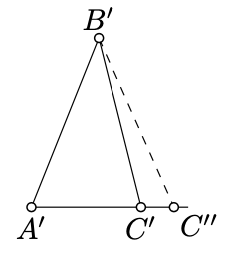4.2: Condición de ángulo-lado-ángulo
- Page ID
- 114604
Supongamos que
\(AB = A'B'\),\(\measuredangle ABC = \pm \measuredangle A'B'C'\),\(\measuredangle CAB = \pm \measuredangle C'A'B'\)
y no\(\triangle A'B'C'\) es degenerado. Entonces
\(\triangle ABC \cong \triangle A'B'C'\).
Tenga en cuenta que para los triángulos degenerados la sentencia no se sostiene. Por ejemplo, considere un triángulo con lados 1, 4, 5 y el otro con lados 2, 3, 5.
- Prueba
-
Según el Teorema 3.3.1, ya sea
\[\begin{array} {l} {\meausredangle ABC = \measuredangle A'B'C',} \\ {\measuredangle CAB = \measuredangle C'A'B'} \end{array}\]
o
\[\begin{array} {l} {\meausredangle ABC = -\measuredangle A'B'C',} \\ {\measuredangle CAB = -\measuredangle C'A'B'.} \end{array}\]
Además suponemos que 4.2.1 sostiene; el caso 4.2.2 es análogo.

Que\(C''\) sea el punto en la media línea\([A'C')\) tal que\(A'C'' = AC\).
Por Axioma IV,\(\triangle A'B'C'' \cong \triangle ABC\). Aplicando de nuevo Axioma IV, lo conseguimos
\(\measuredangle A'B'C'' = \measuredangle ABC = \measuredangle A'B'C'\).
Por Axioma IIIa,\([B'C') = [BC'')\). De ahí que\(C''\) miente tanto\((B'C')\) como en\((A'C')\).
Ya que no\(\triangle A'B'C'\) es degenerado,\((A'C')\) es distinto de\((B'C')\). Aplicando Axioma II, lo conseguimos\(C'' = C'\).
Por lo tanto,\(\triangle A'B'C' = \triangle A'B'C'' \cong \triangle ABC\).


